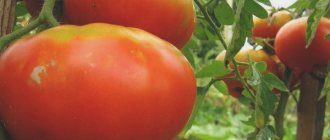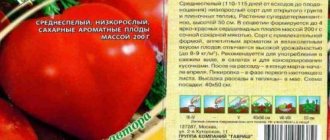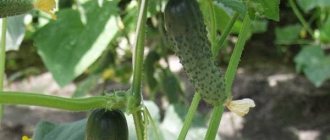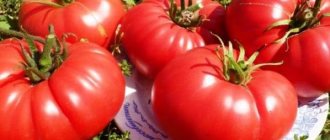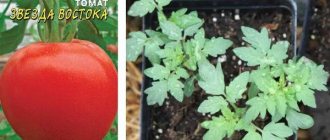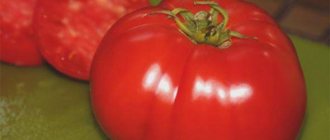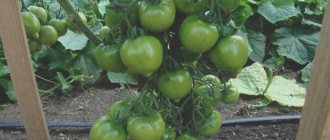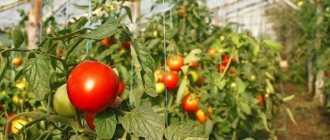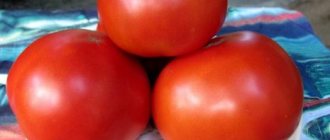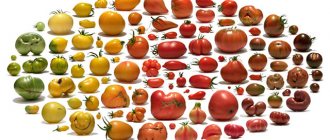The Royal Mantle tomato is a Siberian variety whose name evokes associations with luxury and high cost. The characteristics of the fruit, their size and taste are truly worthy of a royal table. But any summer resident can afford to grow this variety in the garden.
| Height | Landing location | Ripening time | Fruit color | Fruit size | Origin | Fruit shape |
| Tall | Greenhouse, Open ground | Mid-early | Pink | Large | Variety | Flat-round |
General form
The Royal Mantle tomato is recommended by the manufacturer for cultivation in the Siberian regions, the Caucasus, and also in central Russia. A representative of the variety looks like this:
- The bush does not stop growing on its own, that is, it is indeterminate. Under suitable conditions, the tomato reaches a height of 1.8 m.
- The number of leaves on the shoots is average. The plates are covered with small villi and wrinkled.
- The flowers are simple. Inflorescences appear starting from 6-7 nodes. More than 5 ovaries are formed on each brush.
- The tomato bears large fruits weighing 300-500 g.
- The shape of the tomato is oval, flattened on top.
- When ripe, the fruits turn crimson. A green spot remains on the stalk.
According to ripening time | By type of growth | By type of use | By growing method | Fruit weight (g) | Yield (kg/m²) | Fruit characteristics |
| Mid-ripe (100-110 days) | Indeterminate (in a greenhouse 180 cm; in a vegetable garden 150 m) | Universal | For greenhouses and open ground | 300-500 | Up to 20 in a greenhouse; up to 15 in an open garden | Oval, crimson, fleshy |
Attention! A distinctive feature of the variety is the formation of tomatoes of the same size and shape on the cluster.
Characteristics of large-fruited tomato Royal Mantle and agrotechnical requirements
Tomato Royal Mantle is a variety of Siberian selection. Growing large and tasty tomatoes in difficult climatic conditions is not easy, but breeders are working to create unpretentious and hardy tomato varieties.
General characteristics of the plant
The Royal Mantle variety is indeterminate. The powerful bush is distinguished by the rapid growth of green mass, branches well and forms a large number of stepsons. The height of the plant can reach 1.5-1.8 m even when grown in open ground. This complicates care: the gardener has to tie up tall plants and shape them, removing the stepsons.
The gardener’s efforts are rewarded with a bountiful harvest of large tomatoes. 5-6 long flower clusters are formed on the bush. When 6-7 ovaries are formed, it becomes noticeable that 4-7 pcs. have approximately the same size, and the rest are small or completely undeveloped.
To collect a large number of good marketable tomatoes from a bush, they use a method of rationing the number of ovaries. In this case, no more than 7 of the largest ovaries located closer to the stem are left, and the end of the brush is removed. In this case, the tomato yield does not suffer, and the gardener receives larger tomatoes.
From each bush you can collect about 10 kg of large raspberry-red fruits. The weight of each tomato reaches 500 g, but the largest ones can weigh 700 g. It is better to form a bush with 1-2 trunks, since the planting becomes very thick. To provide sufficient light and air to the lower tier, it is recommended to remove the lower leaves to 1/3 of the height of the plant.
Reviews from gardeners indicate that the Royal Mantle tomato does not reduce productivity even with temperature changes or prolonged rains. The description of the variety only notes a significant sourness in the taste of fruits grown in an unfavorable season. But for greenhouse owners, weather factors are not a hindrance.
The variety is resistant to late blight and other fungal infections. Tomatoes picked at the stage of milky ripeness are ripened in boxes in a cool pantry. They do not have such high taste qualities as soil ones, but gardeners have the opportunity to consume fresh vegetables until mid-winter.
Advantages of tomato fruits
The characteristics of the fruits of the Royal Mantle coincide with the characteristics of BIF tomatoes. Large and fleshy fruits contain few seeds. The shape of tomatoes is round, flattened, with ribs at the stalk.
The fruit shell is strong, but not thick. If there is excess rainfall, tomatoes may crack during ripening. The base of the tomato is greenish even when ripe, reminiscent of the collar of the robe worn by a king.
The flesh is a rich pinkish-red color, with a good structure, reminiscent of the consistency of a melon. The taste of tomatoes is sweet with a slight sourness if they ripen on the vine. With excess moisture and lack of solar heat, it changes to classic tomato (sweet and sour).
The juice from fleshy tomatoes practically does not need to be boiled. It will turn out thick and beautiful without it. When boiled, lecho and ketchup with various additives are prepared from the juice. Small, unripe tomatoes can also be used for canned salads.
Agricultural technology for large-fruited tomatoes
The Royal Mantle variety is classified as an early-ripening tomato (90-110 days before harvest). You need to sow seeds for seedlings no earlier than 50-60 days before transplanting to a permanent place. Sowing is carried out according to the general rules, placing the seeds on a layer of soil and planting them to a depth of no more than 0.5 cm. Germination occurs at a temperature of +25°C, shoots appear in 4-5 days.
https://youtube.com/watch?v=FNXGAuLkmIo
Picking is done in the phase of 2-3 true leaves. It is more convenient to grow seedlings in separate containers, so that as they grow, move them away from each other. When picking, seedlings need to be planted in a common box according to a 10x10 cm pattern.
If the seedlings have stretched out, they are placed in grooves 20 cm deep. This way, an additional root system is formed on the plants, which can easily provide nutrition to a large bush and many fruits. The tops of young plants are oriented to the north, and 4-5 upper leaves are left above the soil surface.
In order for tomatoes to grow more actively and bloom faster, 1 week after transplantation, fertilize with complex mineral fertilizer (“Agricola-Vegeta”, “Tomato Crystal”). The next fertilizing is done at the moment of flowering of the first cluster, and then the application of fertilizers is repeated after another 2-3 weeks. Feed at the root during watering.
Advantages and disadvantages
Thanks to many positive characteristics, the tomato is gaining more and more fans.
- The variety is endowed with low sensitivity to temperature changes.
- Tomato is disease resistant.
- Tomatoes are able to ripen after being picked from the bush.
- The variety is characterized by high productivity. During the season, up to 5 kg are collected from the bush.
- Tomato is not too demanding on lighting.
- The taste of the fruit is well balanced with a pleasant acidity.
Disadvantages include the inability for long-term storage and poor transportability.
Tomato masculinity: description of the Auria variety, tomato planting technique, growing rules
Auria is one of the popular varieties of tomatoes, which is also popularly called manhood. This name comes from the oblong phallic shape of the fruit. The presented variety of tomatoes is distinguished by high yield and unique taste. It is not surprising that the male enhancement tomato has gained wide popularity among people who grow tomatoes.
Description of Auria tomatoes
The presented variety is a hybrid. It was bred in 1997 in Russia and was intended exclusively for cultivation in greenhouse conditions. In open ground, Auria tomatoes grow well exclusively in the southern regions.
Tomato manhood
The bush is liana-shaped, and its height reaches from 50 cm to 2 m. Due to the high stem, the plant must be tied up. Despite good flexibility, there is a possibility of damage to the stem. The number of leaves is average.
The fruit of the Auria tomato is cylindrical in shape with a small rounded fork at the end. The average length of a tomato is 13-15 cm, and its weight is from 130 to 250 g. The inside of the tomato is dense, with a small number of seeds.
Fruit ripening occurs from late summer to early autumn. The first fruits appear, as a rule, at the end of July. Auria tomatoes have a sweet taste, which is why they are often consumed fresh, and are also used for making preserves.
Advantages of the variety:
- Resistance to temperature changes
- Low sensitivity to diseases
- Resistance to lack of moisture
- High yield
- Good taste
The disadvantages of Auria tomatoes include demanding fertilizers and high fragility of the stems. In addition, this variety is considered rare, since it is difficult to purchase seeds.
In general, Auria tomatoes are popular because of their original shape, unique taste, and resistance to climate change.
Seed preparation and planting
To obtain a good harvest, the Auria tomato planting technique must be followed. By following the basic rules of planting, the risk of disease is eliminated.
Lat. Solanum lycopersicum
The first stage of planting is preparing tomato seeds. The process begins in February, when the seeds are sorted out, choosing larger ones. The seeds are then placed in a saline solution for 15 minutes. The grains that float to the surface are thrown out, and those remaining at the bottom are subsequently used for planting in the ground. They should be washed well and dried.
Subsequently, the seeds are soaked. To do this, they are placed in a gauze cloth and placed in a glass container containing warm water. The liquid should not cover the grains completely, but only halfway. The soaking time is 12 hours, and you need to mix the water 3 times.
After this, the seeds are placed on a damp cloth and left at a temperature of at least 20 degrees. It is recommended to moisten the napkin periodically to maintain moisture.
If necessary, the seeds are hardened in the refrigerator at a temperature of 2 degrees for 12 hours, after which they are removed and placed in a warm place.
This procedure is repeated several times to ensure tolerance of temperature changes and increase yield.
Seedlings are prepared for planting in the ground or greenhouse. For this purpose, oblong containers or boxes are used, into which soil is poured. Furrows are made in the soil mixture, the depth of which is about 1 cm. The distance between each furrow is 4 cm.
The seeds must be placed in the furrows at a distance of at least 1 cm. After this, the furrows are covered with a thin layer of soil, and a film is stretched on top. Seedlings grow best at temperatures from 28 degrees. Seedlings begin to be grown 60 days before planting in the ground and 45 days before planting in a greenhouse, which is recommended to be done in May or June.
Thus, planting male tomatoes is carried out after preliminary preparation of seeds and cultivation of seedlings.
Care and harvesting
During the period of growth and formation of fruits, tomato manhood requires careful care.
Harvest ripening
It consists of performing the following procedures:
- Regular watering (daily on hot days)
- Garter stem
- Fertilizer application (first feeding during flowering, second during fruit formation)
- Systematic loosening of the soil
This is what can produce a good harvest.
Pest Control
By following the rules for growing Auria tomatoes, you can have up to 14 bunches from one bush. Each brush contains from 5 to 8 tomatoes. The harvest time is, on average, 125 days from the moment of germination. Due to the high density of the pulp, the fruits are not damaged during transportation, but their fresh shelf life is short, which is why it is recommended to preserve tomatoes.
Undoubtedly, the yield of Auria tomatoes directly depends on the quality of care, and therefore in order to obtain a large number of fruits it is necessary to water in a timely and regular manner, fertilize the soil, and improve the condition of the soil.
While watching the video you will learn about growing tomatoes.
Tomato masculinity is a tomato variety that has gained popularity due to its shape and taste. Auria tomatoes are grown in the summer season in greenhouses or in open beds.
Select it and press Ctrl+Enter to let us know.
Tomato
Source: https://PlodOgorod.com/ovoshhi/pasljonovye/pomidor/vesennik-zimujushhij-2.html
Features of cultivation
Proper agricultural technology helps to grow tomatoes with excellent taste. In order not to be disappointed in your choice, you should follow certain rules. 2 months before the planned transplantation, seeds are sown in the ground for seedlings. To develop, seedlings require a temperature of 23-25 °C.
After the onset of heat, the tomato is planted in open beds or in greenhouses. No more than 3 bushes are placed per 1 m². Throughout the growing season, the bush is pruned. Form into 2 stems. A week after replanting, the shoots begin to be tied up. For this purpose, trellises or high supports of another type are installed in advance.
To achieve good yield, 5 brushes are left on each stem. At the end of summer, the top is pinched off. At the same time, the tomato stops growth and puts all its energy into the fruit.
Features of care
Caring for the Magnus hybrid involves tying the bushes to supports. It is necessary to immediately install long sticks or poles so that you do not have to extend them later.
Tie the stem carefully, without damaging it or pinching the brushes and leaves. Leave a small gap.
Magnus tomatoes are tied for the first time when they reach a height of 40-50 cm under the first fruiting cluster.
To obtain optimal yield results, form a bush with 2-3 stems. When the plant reaches a critical size and has formed a sufficient number of fruiting clusters, trim the top to stop growth.
On subsequent clusters, the ovaries will not have time to properly form and ripen, but will only delay the ripening processes of existing fruits. Throughout the season, remove shoots and excess leaves as they wilt.
Removing the lower leaves promotes the flow of substances to flowers and ovaries, preventing the possibility of plant infections. The leaves are pruned after the fruits on the lower cluster begin to ripen.
Magnus tomatoes need abundant, regular, but infrequent watering. Once every 5-7 days is enough, as the top layer of soil dries.
Water the bushes at the roots only with warm water. It is better to water in the early morning or late evening.
Early morning is the ideal time for many procedures. Removing leaves and shoots in the early morning allows the plant to have time to heal the wounds, which will not become sources of possible infection.
Be sure to regularly weed and loosen the soil. Removing weeds improves the ventilation of bushes and prevents plants from being damaged by diseases and pests. Loosening improves gas exchange and enriches the soil with oxygen.
Hilling helps tall tomatoes to form a developed root system and ensure an influx of nutrients. Hilling is carried out with the appearance of small nodules at the bottom of the stem. The second time is when the color of the stem changes to dark blue.
Mulching prevents rapid drying of the soil, the formation of a hard earthen crust, erosion of the soil during watering and exposure of roots. Rotted sawdust, hay, straw, pine needles or dark non-woven material are used.
Periodic light shaking of the flowering clusters helps to increase the percentage of ovary formation.
This makes pollination more efficient. In open ground, tomatoes are helped by wind and insects. In greenhouses and greenhouses their influence is noticeably reduced. It is enough to shake once every few days.
It is imperative to ventilate greenhouses. This helps regulate humidity levels and prevents fungal diseases from affecting plants.
Reviews from summer residents
- Ninel from Tambov. I have been growing tomatoes for several years. The culture is heat-loving, so a greenhouse was specially built. I saw the described tomato in a photo online. I also read information about him there. I ordered seeds and grew seedlings. In the first season, the variety surprised me with the size of its fruits. The weight of some reached 700 g. We had to tie up not only the stems, but also the tomatoes themselves. I really liked the taste.
- Maria from Voronezh. I planted a tomato without shelter in the garden. I tied it to a high support, formed it into 2 stems, and pinched it. A couple of times a season I treated it with antifungal drugs for prevention. The tomatoes were a great success. Large, fleshy. It was enough to eat fresh and prepare juice and pasta for the winter.
- Dmitry from Tula. This is not the first year I have been planting the presented tomato. Every season the variety bears many delicious fruits, regardless of the temperature. In May, I left for a couple of days, but forgot to close the window in the greenhouse. Most of the tomatoes have shed their ovaries, but this one doesn’t matter.
Royal Mantle is a variety worthy of a loud name. Under any circumstances, the tomato will bring an excellent harvest and will delight you with its taste.
Tomato Magnus: characteristics and description of the variety
When planning to grow a Magnus tomato, you should study the description of the variety: not only the main characteristics of the plant, but also the ideal timing of sowing seeds, moving seedlings to a greenhouse or beds, watering schedule and optimal composition of fertilizing. If you strictly follow the instructions, you can achieve a good harvest and smooth ripening of the fruit.
When planning to grow Magnus tomato, you should study the description of the variety
Characteristics of tomatoes
Magnus is a promising and high-yielding hybrid of the first generation, bred by Dutch breeders. The tomato combines early ripening with good yield and high taste of the fruit.
Typically, tomatoes with a short growing season do not have very high consumer qualities, but this variety is a clear exception to the rule. Ripe tomatoes are distinguished by their attractive appearance, delicate but bright aroma, balanced taste without wateriness and herbal notes.
All these advantages make the plant an ideal option for growing in personal backyards and on small farms.
The hybrid is zoned for the Central region of Russia, but can be grown in any area. Plants feel best in film, polycarbonate or glazed greenhouses. The shortened growing season makes it possible to plant tomatoes in mid-spring; the harvest can be harvested in the first half of summer.
In regions with a warm climate, you can try to grow seedlings in open beds, but in this case the yield is slightly reduced.
Magnus is a promising and high-yielding hybrid of the first generation, bred by Dutch breeders
Magnus has good resistance to diseases and pests. The hybrid is rarely affected by cladosporiosis, verticillium, and root-knot nematodes. Cases of virus infection are rare. Early ripening protects seedlings from late blight of fruits and leaves.
Also read: Tomato Khorovod: characteristics and description, reviews from farmers
Description of the plant
The hybrid is an early ripening hybrid; 95 days pass from the emergence of seedlings to the harvesting of the first fruits . The bush is semi-determinate, moderately spreading, the formation of green mass is average. The leaves are large, dark green, the stems are strong, juicy, and not prone to brittleness.
Light shaping is necessary with the removal of excess shoots, but heavy pruning will not benefit the plant. The inflorescence is simple. The tomatoes ripen in beautiful small clusters of 4-6 pieces; at the moment of active fruiting, the bush looks very decorative.
Fruits can be picked in clusters or individually, in a state of physical or technical ripeness.
The tomatoes are flat-rounded, with pronounced ribbing at the stalk. The color is deep red, without spots or stripes. The skin is thin, but quite dense and glossy. The fruits are smooth, medium-sized, but very beautiful.
The average weight ranges from 140 to 160 g. In appearance, Magnus resembles a Matias F1 or Eigen F1 tomato, but the latter is more impressive in size (average fruit weight is from 180 to 200 g).
The pulp is juicy, has few seeds, and the chambers are small.
Such tomatoes can be used for whole-fruit canning or included in assorted vegetables. The rich, bright taste makes tomatoes suitable for making soups, sauces, purees for baby food, and bright red thick juices.
Magnus is best propagated by seedlings
The hybrid has excellent taste. The pulp contains a lot of sugars, solids, lycopene, vitamin C and amino acids. The tomatoes are aromatic, sweetish, with light fruity notes. Close analogues in taste are tomato Schastie Russkoe F1, Berberana, Belfort, Gilgal, Eigen F1, Mondial, Sovereign. Gardeners who have already tried these hybrids will certainly like Magnus.
Its big advantage is its early ripening. The listed plants begin to bear fruit 10-15 days later. Another interesting analogue is the pink-fruited tomato Lily Marlene F1, which is often grown in the same greenhouse with Magnus due to similar agrotechnical requirements.
Also read: Tomato variety Roma: characteristics and description
Advantages and disadvantages
The advantages of the Magnus F1 hybrid include:
- high productivity;
- early amicable maturation;
- excellent taste of ripe tomatoes;
- low maintenance requirements;
- resistance to cladosporiosis, verticillium, root-knot nematode;
- the ability to grow in any shelter - from ordinary greenhouses to heated greenhouses;
- versatility of fruits;
- availability of seed material.
Experienced gardeners highly appreciate the consumer qualities of the hybrid. Magnus F1 cannot be classified as a new product; it has been successfully grown for several years. Reviews from professionals and amateurs note stable yields, good taste of ripe tomatoes, and resistance to pests and diseases. A close analogue is the Indio F1 tomato; these plants can be grown in the same greenhouse.
Magnus tomatoes have few disadvantages. They are picky about the composition of the soil and love generous fertilizing and proper watering. Under favorable conditions, productivity increases significantly. In the first generation, hybrids can produce seeds, but the resulting seedlings do not carry the qualities of the mother plants.
Subtleties of cultivation
Magnus is best propagated by seedlings . When planted directly in the ground, tomato seeds will germinate too late, which will significantly reduce the yield.
Depending on the region, sowing begins in late February or early March. Picking can slow down the growth of seedlings.
Young tomatoes must be fed with liquid complex fertilizer, since the hybrid prefers nutritious soil.
Magnus tomatoes have few disadvantages. They are picky about the soil composition and love generous fertilizing and proper watering.
The seedlings are moved to the shelter in early or mid-May. A good neighbor in the greenhouse will be the Bagheera F1 tomato, which is also an early ripening tomato. The plants are tied to supports, and the lower leaves are removed for better insolation.
It is possible to form 2-3 stems, the remaining stepsons should be removed. Gardeners who want to extend the harvest period can supplement Magnus with the later Belle F1 tomato.
The tomato duet will allow you to harvest until the end of summer.
A promising hybrid of Dutch selection suitable for most subsidiary plots. By planting Magnus in a greenhouse or in garden beds, you can count on a decent harvest and wonderful taste of ripe tomatoes.
Also read: Fattening tomatoes in a greenhouse: reasons and methods of control
(2 4,50 of 5) Loading...
Source: https://sadovodu.com/2017/03/tomat-magnus-xarakteristika-i-opisanie
Palace tomato, reviews, advantages, features of planting and care
The Dvortsovy variety is resistant to diseases and slight fluctuations in air temperature, which is noted by many gardeners. The fruits are known for their pleasant taste with a slight sourness and are perfect for salads, sauces and ketchups.
The Palace tomato variety is distinguished by its unpretentiousness, high productivity and sustainability. Recommended both for planting in open ground and for greenhouse cultivation. The article will tell you about the features of this variety and the rules of cultivation.
Description of the variety
The early variety of tomatoes compares favorably with others in a number of indicators. It grows and bears fruit remarkably in the south of the country; in the north and west it produces good yields in greenhouse conditions.
Other features of the variety include:
- Belonging to tall varieties, the bush itself is spreading and can reach a height of up to one and a half meters;
- The inflorescence is simple. The first develops at the level of the seventh leaf;
- Has a high level of productivity;
- The berries are flat-round, ribbed, early ripening and have few seeds. Color – deep red;
- The weight of the fetus can reach six hundred grams;
- The leaves are slightly pubescent and irregularly shaped. The color of the plates is bright green;
- Resistant to fungal diseases and slight temperature fluctuations.
To get a larger harvest, many gardeners recommend not neglecting the need to form a crown. The best option would be to leave two or three branches for greater fruiting.
The Palace tomato is distinguished by its high productivity and fruit quality. Suitable for both greenhouse cultivation and open ground planting, depending on the climatic region.
Landing Features
To grow this variety in open ground or greenhouses, seedlings are mainly used. Of the planting material of the tomato variety Dvortsovyi Biotekhnika, reviews are predominantly positive. That is why many summer residents prefer Biotechnics to sow seeds.
Growing seedlings and subsequent planting includes a number of rules:
- Before directly sowing the planting material, it is necessary to pour the seeds with a light solution of potassium permanganate and let them stand for half an hour. After this, moisten with a growth activator and let dry;
- To plant seeds, it is necessary to prepare a substrate (a mixture of turf soil, peat and coarse sand). Place it in a small container and sow the seeds;
- It is better to water with a spray bottle, using pre-settled water at room temperature;
- Place containers in a warm, well-lit room;
- After sprouts with the first pair of leaves appear, it is recommended to dive;
- After two or three days, seedlings can be transplanted into peat containers;
- A week before planting in open ground, it is recommended to fertilize the soil with mineral fertilizers;
- When planting, it is worth considering that per 1 sq. m. there should not be more than four bushes with a distance between them of a third of a meter;
- The distance between rows of tomatoes should not be less than half a meter;
- Before planting, it is recommended to fill the bottom of the holes with wood ash;
- After planting, mulch the soil near the bushes with sawdust.
The Palace tomato is a persistent and not very demanding plant. If all planting and care rules are followed, it will delight gardeners with a high level of productivity by the end of the season.
Care instructions
Basic recommendations for caring for planted seedlings include:
- The beginning of active watering should occur at the end of the first week after planting in the soil;
- It is worth watering with pre-settled water, at a temperature of at least twenty degrees. You need to water in the morning at the root of the plant once every three days before flowering;
- If the plant is planted in a greenhouse, the air temperature should not fall below eighteen degrees. Do not forget about the need for regular ventilation;
- Since this variety is tall, three days after planting, the bushes need to be tied up;
- Ten days after planting, you need to make the first fertilizing.
The Palace tomato is unpretentious and does not cause any particular difficulties in care. Resistant to many diseases, including fungal ones.
Advantages of the variety and disadvantages
The main advantages of the variety include:
- Early ripening and large size - like the F1 tomato, the supergiant is pink, grows quickly, produces large fruits;
- Disease resistance;
- Unpretentiousness - recommended for cultivation both in open ground in the south and in greenhouse conditions in the west;
- High yields;
- Excellent taste.
There are practically no disadvantages to tomatoes.
The only negative aspects include:
- The need to tie up bushes;
- Frequent fertilizing.
In percentage terms, the number of disadvantages is significantly inferior to the advantages, which already says a lot.
